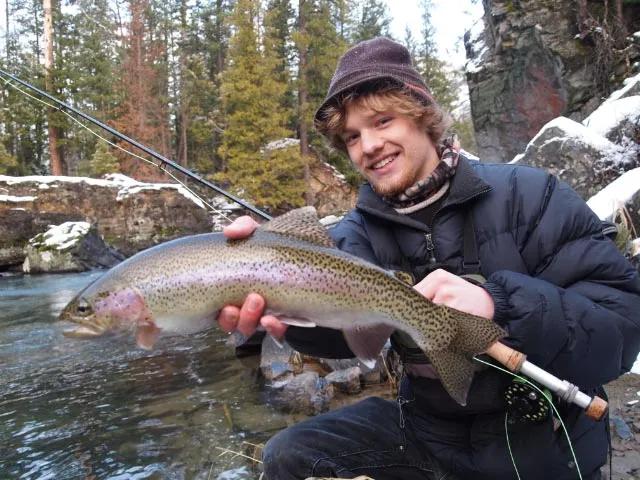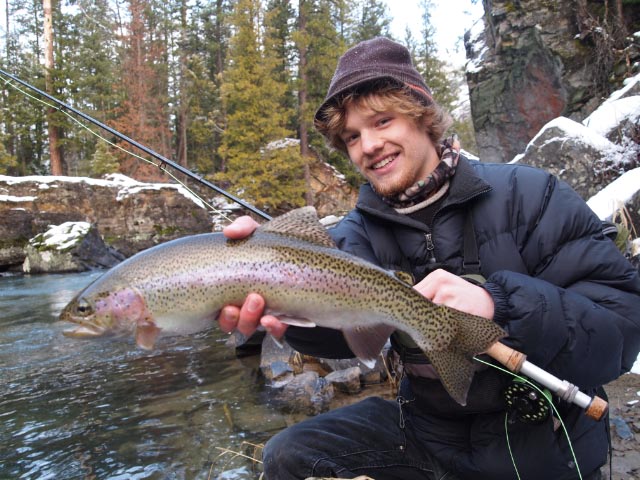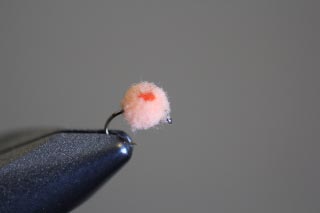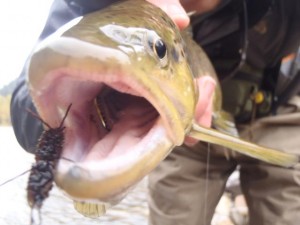
Rock Creek is a 52-mile long anglers haven located west of I-90 and just 30 minutes south of Missoula. On any given day you can hit a “grand slam” by catching beautiful browns, rainbows and west slope cutthroat and even the occasional brookie. The river corridor is surrounded by pristine land of the 2 million acre Lolo National Forest and is widely considered to be one of the most scenic trout rivers in Western Montana and the home waters of our partner the Blue Damsel Lodge. The smaller size of Rock Creek and ample public land make it a favorite location for wade fisherman.
One of our favorite times to visit Rock Creek is in the colder winter months. You have every hole to yourself and, if you’re lucky, will not see another angler all day. Western Montana has a milder climate than farther south and it only freezes over during the coldest arctic blasts. The colder water temps drive trout into easily targeted slow and deep runs.
Fly selection in the winter is fairly easy due to the limited food sources. The brown trout and whitefish spawn proceed the winter months and and eggs are periodically flushed off the redds helping to nourish trout throughout the entire winter. It is no surprise that egg patterns are effective in the off season. During the frigid winter months trout’s metabolisms slows down and they become very lethargic. Unless you literally hit them in the face with a small nymph, they will not make the effort. Large offerings such as stone fly nymphs and egg patterns are a go to choice for winter. A stonefly’s life cycle can last up to three years depending on the species, so there are always stonefly nymphs to be found in the water. Rock Creek has a robust salmon fly population (Pteronarcys californica) and these massive insects are a favorite of trout. Few trout will let such a well placed egg or stonefly nymph go by unscathed. It is imperative to get your nymph rig down deep enough to where the fish are. The rocks create friction making the current on the bottom of the river the slowest, making a suitable lie for trout. If your nymphs are not ticking the bottom every once in a while, you are not down deep enough. Split shots are essential in the winter to achieve this. When nymphing the ever popular “steak and eggs” combination of a stonefly pattern on top trailed by an egg pattern is a good place to start and often all that is needed for an afternoon of fishing. Fly selection isn’t rocket science in the winter months. Midge larva and small immature mayflies are also prevalent in Rock Creek. Midges can be especially important in the later winter months of February-early April when daily hatches can occasionally produce a few snouts on the surface. Dry fly fishing is a big bonus in the winter and most days nymphing will be the name of the game. If the steak and eggs combo isn’t producing dropping a midge larva behind one of the larger patterns can sometimes do the trick.
One of the keys to successful winter fishing is to make sure you are fishing where the trout are. About 95% of the river is devoid of trout in the colder months. Nearly all of the trout in the river will be jammed into a few slower and deeper runs. Anglers need to skip all of the gorgeous riffles and swift pocket water that produces in the summer months and seek out slower, deep runs where trout have protection and don’t have to work hard. These runs can often hold over a hundred trout each and on a good winter afternoon you may only need to string one or two of these productive pools together to rack up a lot of fish. Unlike the rest of the year, fishing in the morning and evening is less productive than the middle of the day when the sun is on the water. 11:00 to 4:00 is prime time. This allows optimum time for the water temperature to warm up and for you to enjoy a leisurely morning. Also, this gives you ample opportunity to catch some Trout Slayer beers at a local Missoula brewery after a productive day on Rock Creek. Rods, leaders and tackle A five or six weight is perfect for winter fishing. A longer 9 or 10 foot rod helps to manage a drift which is very important during winter fishing. We like a longer leader - often a 9’ that is custom built to have a longer tippet area to help flies sink directly below the indicator. It is important to match the weighting of your rig to the bottom so flies regularly tick off of rocks - trout don’t work hard in cold water and won’t rise high in the water column to take flies. Since trout don’t move far to take flies and they are in slow water to start with the motion on the strike indicator will be very subtle. Fishing a yarn indicator in the winter will help to see the delicate flutters that are often a take. Strike first and ask questions later when fishing slow runs with lethargic trout. If you expect your indicator to get yanked under expect a slow and unproductive day even though trout are most likely taking and spitting your flies on a regular basis. Flies for the Winter Months on Rock Creek Fly selection is about as easy as it gets when waters are cold. A few stonefly patterns, egg patterns and midge larva or smaller baetis nymphs are all that is needed. If the trout aren’t eating you are better off waiting until peak midday hours or even better moving until you find fish. Spending time going through your fly box is generally not needed if you can find the heavily concentrated winter runs. Here are a few flies that always produce in the winter: Egg Patterns Eggs are relatively abundant in river systems throughout the winter following the fall spawn of brook trout, brown trout and whitefish. Pick your favorite pattern but always have a few in your box.
Stoneflies golden stones, yellow sallies and salmon flies are all abundant in Rock Creek. The larger goldens and salmon flies have a longer life cycle and are the top choice for winter trout. You don’t need to get to fancy on your patterns and goold ol’ rubber legs will work just fine.
Midges Midges are abundant and become more important in the later winter months of February and March when some early hatches occur on warm days. Midge larva trailed behind and egg or stonefly sometimes can fool some pickier fish.





